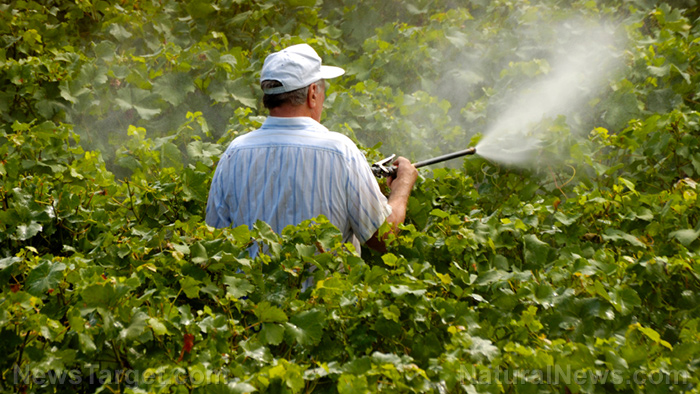Chlormequat — toxicity, side effects, diseases and environmental impacts
12/08/2017 / By Rita Winters

Chlormequat, or chlormequat chloride, is a plant growth regulator that is used on ornamental plants. It works as a lodging (stem bending) and cell elongation (excessive growth) inhibitor. Chlormequat compounds are white (sometimes colorless) crystals with a fish-like or common amine odor. It decomposes on heating, producing toxic and corrosive fumes including nitrogen oxide and hydrogen chloride. Contact with strong oxidizers may start a fire and explosions. Chlormequat chloride is the most important biosynthesis inhibitor of plant hormones that regulate growth and other developmental processes. It results in thicker and sturdier stalks.
Other names and synonyms of chlormequat include: 2-chloroethyl(trimethyl)azanium;chloride; CAS 999-81-5; EC 213-666-4; chlormequat chloride; chlorocholine chloride; CCC Plant growth regulant; Ammonium, (2-chloroethyl)trimethyl-, chloride; Ethanaminium, 2-chloro-N,N,N-trimethyl-, chloride (1:1); Trimethyl-.beta.-chlorethylammoniumchlorid; Chloroethyl trimethyl ammonium chloride; and 2-chloro-N,N,N-trimethylethan-1-aminium chloride.

List of known side effects
Chlormequat is a chemical used to inhibit plant growth. There have been many reports of chlormequat poisoning, and lab tests show toxicity in animals. It is harmful if swallowed, causes mild skin and eye irritation, and may also be harmful when inhaled. It may cause damage to human body organs. Chlormequat is harmful to aquatic life forms.
Specific negative side effects include nose irritation, skin irritation, eye irritation, throat irritation, lung irritation, coughing, shortness of breath, fluid build-up in lungs (pulmonary edema), nausea, vomiting, irregular heartbeat, tremors, seizures, and coma. Chlormequat may possibly be fatal.
Accidental ingestion of Cycocel (containing chlormequat) results in cholinergic (relating to nerves) crisis that leads to sudden death. A 59-year old male, who was a nursery worker, accidentally drank a mouthful of Cycocel, mistaking it for a bottle of water. Electrocardiogram (ECG) results showed a T-wave inversion (sign of coronary ischemia or ventricular hypertrophy) and a flat augmented vector foot aVF (indicating need of hemodialysis due to sudden kidney failure). After hospitalization, the patient suffered a seizure with bradycardia (slow heart beat), dysrrhythmia, and ventricular fibrillation, which eventually resulted in asystole (cardiac arrest).
Poisoning may happen through inhalation, ingestion, and skin and eye routes of exposure. Long-term or repeated exposure, especially to large doses of chlormequat may result in chronic health effects. There is no evidence of carcinogenicity from chlormequat, and there is not enough evidence to assess its teratogenicity.
Body systems affected by chlormequat
Chlormequat may affect the skin and the respiratory, nervous, and muscular systems. It may also cause liver damage and other endocrine disorders.
Items that can contain chlormequat
Food items that may contain traces of chlormequat include wheat, triticale, barley, rye, tomatoes, cabbage, cauliflower, and radish. Ornamental plants that may have residues include geraniums, pelargoniums, and poinsettia.
How to avoid chlormequat
Chlormequat is a chemical used in commercial farms. It may also be used in public places maintained by the government, including parks and gardens. Commercially, establishments with greenery may also be using this chemical. Traces or residues of this growth inhibitor may exist on the leaves of plants up to 100 days.
When handling the chemical, make sure to use protective clothing including chemical gloves, boots, long-sleeved chemical suit, and a full-face respirator. Only trained and authorized personnel should handle toxic chemicals such as chlormequat. Minimize risk of exposure on the skin by washing skin thoroughly after use. Keep the chemical locked in a cool and dry place, away from ignition sources or direct sunlight.
For accidental inhalation, ingestion, or skin and eye contact, transport the victim to the nearest emergency department as soon as possible.
Where to learn more
- Researchers share how to conquer herbicide-resistant superweeds that threaten the food supply in the Midwest
- Poison.news
- Chemicals.news
- Pesticides.news
- Toxins.news
Summary
Chlormequat is a plant growth inhibitor.
Chlormequat may have serious side effects in humans.
Chlormequat may be fatal in large doses or with prolonged, repeated exposure to it.
Sources include:
Tagged Under:



















